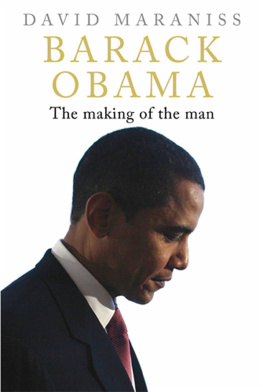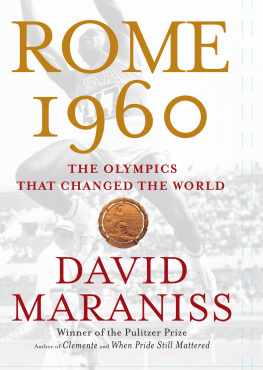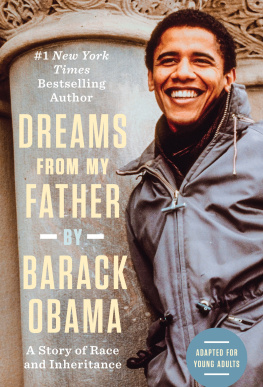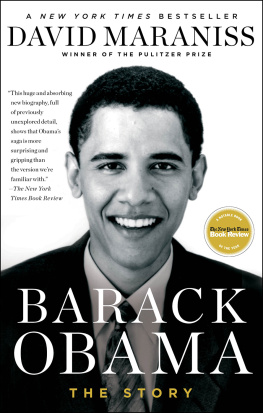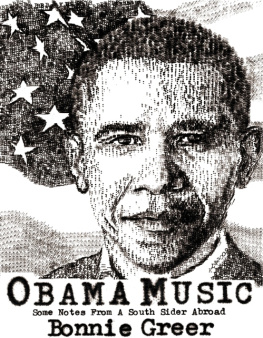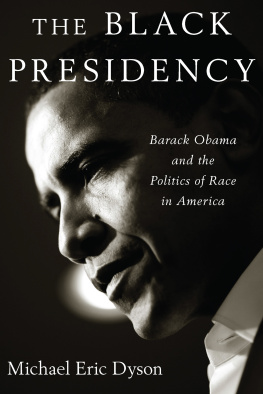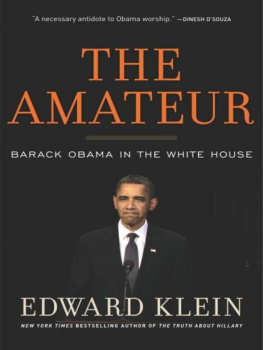BARACK
OBAMA
The Making of
the Man
ALSO BY DAVID MARANISS
Into the Story
Rome 1960: The Summer Olympics That Stirred the World
Clemente: The Passion and Grace of Baseballs Last Hero
They Marched into Sunlight:
War and Peace, Vietnam and America, October 1967
When Pride Still Mattered:
The Life of Vince Lombardi
The Clinton Enigma
First in His Class: A Biography of Bill Clinton
The Prince of Tennessee:
Al Gore Meets His Fate (with Ellen Nakashima)
Tell Newt to Shut Up! (with Michael Weisskopf)

First published in the United States of America in 2012 by Simon and Schuster.
First published in Great Britain in 2012 by Atlantic Books,
an imprint of Atlantic Books Ltd.
Copyright David Maraniss, 2012
The moral right of David Maraniss to be identified as the author of this work has been asserted by him in accordance with the Copyright, Designs and Patents Act of 1988.
All rights reserved. No part of this publication may be reproduced, stored in a retrieval system, or transmitted in any form or by any means, electronic, mechanical, photocopying, recording, or otherwise, without the prior permission of both the copyright owner and the above publisher of this book.
Every effort has been made to trace or contact all copyright holders. The publishers will be pleased to make good any omissions or rectify any mistakes brought to their attention at the earliest opportunity.
10 9 8 7 6 5 4 3 2 1
A CIP catalogue record for this book is available from the British Library.
Hardback ISBN: 978-1-84887-279-0
Trade paperback ISBN: 978-1-84887-280-6
E-book ISBN: 978-0-85789-856-2
Atlantic Books
An imprint of Atlantic Books Ltd
Ormond House
2627 Boswell Street
London
WC1N 3JZ
www.atlantic-books.co.uk
To the wondrous girls of my life
Linda, Sarah, Ali, Heidi, Ava, and Eliza
and to Alice
The mind that has conceived a plan of living must never lose sight of the chaos against which that pattern was conceived.
RALPH ELLISON , Invisible Man
BARACK OBAMA

INTRODUCTION
Its Not Even Past
O n a whitewashed ledge at Punahou School bathed in Honolulu sunshine, we sat and talked about the past, revisiting the days when Alan Lum and his friend Barry were teammates on Hawaiis state championship basketball team. Then we got up and took a short walk. We left the athletic center and strolled past the prep schools outdoor pool, constructed after their days there in the late 1970s, and along the edge of a vast green playing field, before climbing the broad steps leading up to the Dole cafeteria. Lum turned left on the Ianai and cast his eyes downward. Where was it, again? He walked farther toward a set of outdoor benches, then stopped and brushed the pavement with his shoe, cleaning away the daily soot. There it was, etched in block letters decades ago by a stick or index finger before the concrete had set: OBAMA .
No historical marker designated the site. Generations of students had walked over and around it without taking notice of the name below their feet. For the first twenty-five years or so after it was written, the name would have provoked little interest in any case. Just one name among multitudes, and locals might have assumed Obama was Asian American; the syllables had a familiar Japanese cadence. The testament of a teenage boy, and he didnt even write it himself. The story goes that one of his buddies scratched his name there to get him in trouble. But it had the same meaning nonetheless: A name etched in concrete, like Kilroy was here carved into rock, is an expression of time and history and fleeting existence. Looking down, I could only think: That could have been the only mark he left.
One April morning in Topeka, the capital of Kansas, my wife and I went searching for an address in the eleven-hundred block of Sixth Avenue. Long ago there had been an auto garage there the Palace, it was called and a drugstore next door. In the intervening decades, as often happens, addresses had changed and seemed two or four off from what they had been in the 1920s. The drugstore had vanished. A wide driveway now opened from the avenue into a few parking spaces in front of a nondescript building. A sign said it was an auto repair shop, an unwitting reiteration of what once had been. In front, a single-room office had gone up in recent decades, sparsely furnished with desk, telephone, and shelves of manuals, but farther into the interior was the old garage, with a high-ceilinged work area where one could envision the scene from more than eighty years earlier: a mechanic in overalls sweating under the hood of a Studebaker Big Six. Windows had been bricked up, and most of the old tin ceiling had been covered, but the place seemed to trap the dust and suffocating air of the past.
The shop manager was obliging and let us look around. As we stood in the dingy garage, staring up at the ceiling, I asked whether he knew the buildings history. It had undergone many transformations over the years, he said. There had been a pharmacy attached to it once, and next to the pharmacy was an apartment building. According to legend, the landlord had built a secret passageway from the shop to the back door of one of the apartments, where his mistress awaited for illicit trysts. Quite a story, but there was another bit of history about which the present-day tenants knew nothing. It was in that very garage that Barack Obamas great-grandmother Ruth Armour Dunham took her own life on a chilly Thanksgiving night, setting off a chain of events that changed the course of American history.
Out in the western reaches of Kenya, a harrowing seven-hour drive from the capital city of Nairobi, in the region hugging the uppermost gulf of Lake Victoria, I encountered a tale of two villages. The first village was Nyangoma Kogelo, in the brushland northwest of the major city out there, Kisumu. That is where a woman known as Mama Sarah lived. She had become a celebrity in Kenya as the step-grandmother of Obama and a figure in his best-selling memoir. A trip to her compound now was like visiting royalty. The entrance was gated. Vendors sold tourist trinkets at tables just inside the grounds. She was connected to the outside world by giant satellite dishes, and protected by armed guards. There were lists to be checked, names to be vetted, rules to be imposed, factotums to accommodate. Mr. David... David, said one young relative during his inquisition in the shade of a mango tree, stopping to assess my name and worthiness. Is that Christian or Jew? Both, I responded. All to see a woman who had no blood relationship to the famous American and was, as one Kenyan put it, nothing more than a historical accident.
The second village was Oyugis. It was around the gulf, down and to the east, a bumpy journey into the hills of southern Nyanza. An old toothless woman named Auma Magak lived there with several relatives, including her son, Razik. In her seventies, Auma was a recovering alcoholic who scratched out a living by selling charcoal from a shack by the side of the road. It was Auma, in her isolation and anonymity, who had the strongest link to the Kenya side of the Obama story. She was the younger sister of Barack Hussein Obama Sr., the presidents father, and in a tribal culture where polygamy was routine, her bloodlines were the most direct because she and Obama Sr. had the same mother and father. Her compound was not on the tourist maps. It was surrounded by high euphorbia bushes, but no guards checked visitor lists and there were no vendors selling trinkets. Yet step inside her hut, into the darkened stillness, and there were the testaments on her mud walls: four framed photographs of President Obama with his wife and two daughters, along with two posters and a calendar from his most recent visit as a U.S. senator. And she and Razik had stories. She talked about how her mother ran away from a brutal husband and how the little children, including Obama Sr., ran after her. Razik recalled the time in the late 1980s when his American cousin came to visit and they went fishing for Nile perch in the great lake and drank

